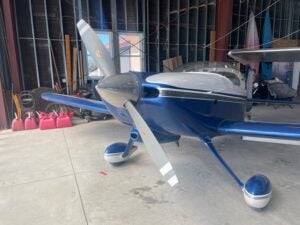
As anyone who studied for their private pilot exam 50 years ago should know, airplane propellers should be parked horizontally—that’s so that when it rains, and the wood of the prop gets wet, both blades absorb the same amount of water, and you don’t get a heavy blade. Yeah….this is still technically correct, but really only applies if you have a wooden prop, and while there is probably a higher percentage of wood props in the E-AB world than on SPAM cans, most pilots are now flying behind metal or composite.
Wandering around our hangar this morning, with airplanes of different sizes and stances, I noticed that I have a different system for parking props—all of which are either metal or composite—that make the hangar safer and more navigable. And no, none of the props are parked horizontally.
The RV-3 sits kind of low (it’s a small airplane) but the prop has three blades and sort of long—one of those blades could stab you right in the eye if not positioned properly. One blade straight down keeps you from banging that one with your legs, but that puts the tips of the other two right at eye level, so one blade straight up seems to be the safest configuration; it puts the other two tips low, so they just take out your knees.

The RV-6 has a two-blade prop, and sits sort of like a low-rider. If you put the prop horizontally, you get stabbed in the throat if you approach the nose from the side, so vertical (or slightly canted off vertical) is good. Slightly canted is better in case someone lifts the tail—you’d hate to stub the prop blade on the floor if it was vertical!
The Tundra sits tall on its big tires, and frankly, you could probably put the prop horizontally and few would walk in to it, but we’ve got a few tall guys in the airport who drop in once in awhile, so vertical is safest.
The RV-8 is hiding in the workshop space so no picture, but with its three-blade prop on a nose held proudly high, it is similar to the RV-3—just don’t leave one blade horizontal or it will stab you in the eye before you see it.

And lastly, there’s the propeller-less ankle-biter… the Subsonex. No prop, but that pitot tube sits right at shin-level, just waiting to trip you. Once you see it, you can’t look away – you’re like a moth attracted to a porch light… you can just see yourself walking through it. So we have to give it as wide a berth as a prop, just to keep us—and the airplane—safe.
If it’s just one airplane in a T-hangar, you can do what you like but if you coexist with other machines in group hangar, propeller parking is something to think about!














I have mine “indexed” so that when it stops it is in the horizontal position. I had an engine out with a nose gear collapse and the prop was “indexed” to stop in the vertical position well guess what the prop was damaged because it was vertical and had it stopped horizontal probably would have been no damage. There was no other damage to the airplane and once we replaced the nose gear (experimental and a couple of hour job) we could have flown it out but not with a broken prop…
That’s a good reason to index your prop so you know where it stops – but you can then move it to wherever you need it for storage (so long as you know that your P-leads are grounded, or your EI is truly “off”.
Not related to just props, however, I still have the dents in my shins from the tie-down chains of the S2F’ss on the hangar deck
of the Randolph over 60 years ago…ouch
Can one find and use a 4 bladed Prop on a Plane normally has only 2, maybe 3 blades? Or is it Strictly Engine Torque & H.P. that Determines that?
Leaving a two blade prop horizontal on an aircraft parked outside in the spring will provide a lovely perch for birds.
They will then notice the cooling inlets and move into your cowling.
That will happen very fast in some cases where you didn’t install inlet plugs or cowling covers.
Leave the prop somewhat off vertical; if vertical, some bird may perch on top and relieve itself.
Loved your article. I have a 3 blade catto on my 7. I prefer the 1 blade up, as It works great until I do some work on the mains or under the cowl. I know the blades are there, but one always seem to bite me.